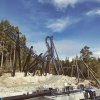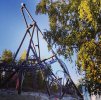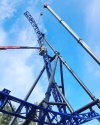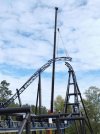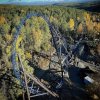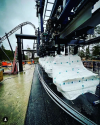I’d never seen the shear plate though - does its existence mean there has to be a base plate welded beneath it to transfer stress to, or can it sit directly on top of concrete?
I'm not sure I understand the question so I'm going to go further in depth in hopes of explaining it better. Below are some photos that I've found from
WKRC News in Cincinnati from when Orion was built and they help explain the process.
First, when I refer to a base plate, I simply mean the plate that is welded at the bottom of all tubular supports. Sometimes they have the shear key welded to them and sometimes they don't.
When building a coaster, typically what happens is you pour footers with anchor rods in them and pockets in the center to accommodate a shear key during initial construction. Below is a perfect example of this:
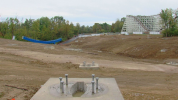
You can clearly see the footer, the six anchor rods with nuts already on them, and a pocket for a shear key. When you get ready to place a support, you twist those nuts down and survey them to make sure they are at the right height. Then you place the support on top of them and take six additional nuts (and plate washers) and tighten the support in place. For the remainder of the structural construction, the base plate/support will sit there fully supported by the nuts/plates/anchor rods. Below is a good photo of this:
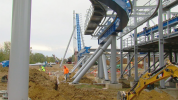
You can clearly see a gap between the base plate and the footer. You can also see the shear key going down into the pocket. You leave this gap and pocket open until the structure is complete. That allows the structure to find the place it wants to "live." Then, you go to each footer and you fill in this gap and pocket with grout.
Below, I've zoomed into a footer in a photo I took of Fenix (no, I didn't take a photo of just the footer

). You can see the grout that was poured to fill the gap between the base plate and the footer. This essentially locks the shear key into place. So rather than the anchor bolts absorbing lateral/torsional load, the foundation absorbs it via the shear key. The anchor bolts keep the support from lifting. The footer keeps the support from sinking. The shear key keeps the support from sliding or twisting.
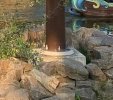
So, that's an explanation of the more common process. Obviously, Gerstlauer doesn't do it that way. I really have no idea what their base plates rest on down within those hollow footers that they've poured. I would think that there has to be some sort of steel ring that is set within the concrete and surveyed so that they know the support is at the right height, but I really don't know what their exact process is. I'm a bit perplexed.
The bottom of Saw’s first drop for example - I’d always assumed the supports had come slightly loose from the concrete they’re contained in which gives the strong jolt as cars pass over it, allegedly made worse by slight subsidence here in the watery ground. Not sure how accurate that is but in all cases you’d assume tracks would give a smoother ride if fully bolted down, rather than relying on concrete adhering the supports in place.
I haven't ridden Saw, but it's not outside of the realm of possibility that the support is coming loose and that's not a problem that is specific to Gerstlauer. It can happen with coasters that have track bolted directly to the footer, such as the case when you have a section of track that drops essentially all the way to the ground on a first drop. A connection plate on the track will often be bolted directly to the footer without any sort of support column in between. A structural support helps absorb vibration. However, without a support between the track and footer, the repeated vibration and beating the track takes from the train passing over gets passed directly into the footer and can deteriorate the bond between the anchor rods and the concrete over time.
It seems so mad that one manufacturer has a completely different process from all the others (as well as being the one with more of a reputation for roughness).
It is certainly strange, but every manufacturer designs and builds rides a little differently and they all have their reasons for their approaches. I'm sure there is a decent reason for Gerstlauer's approach.
That being said, there are also a number of reasons why a steel coaster can be rough. Track manufacturing is often a huge factor as are the trains/wheel assemblies. The actual assembly of the track on site can be a huge factor too. If you don't have completely smooth and seamless connections between the rails, then it can lead to a rough ride. That's why a lot of times you can spot places on brand new coasters where the paint has been removed from the rails near a connection point; they've been grinding on the rails to smooth out the transition between pieces.





